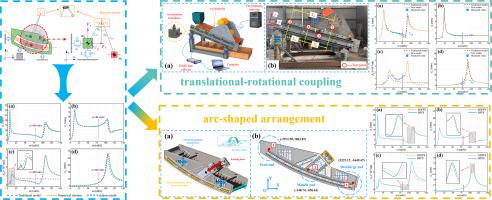考虑弧形排列和动转耦合效应的香蕉转流筛动力学
IF 4.6
2区 工程技术
Q2 ENGINEERING, CHEMICAL
引用次数: 0
摘要
振动转流筛是湿细颗粒深度筛分的必备设备。香蕉转流筛的弧形布置特性有助于调节物料流速,从而控制物料层厚,提高筛面利用率。然而,现有的bffs动力学模型往往忽略了圆弧布置特性和双体系统的平移-旋转耦合特性引起的相对运动的影响。为了反映实际运动特性,利用拉格朗日方法建立了考虑圆弧布置特性和双体系统平移-转动耦合特性的动力学模型。通过多体动力学仿真和实验验证了该模型的有效性。弧形排列特性显著影响主屏框角振幅Aθ的二阶共振峰和反共振位置。对于主筛框在x和y方向上的振幅Ax和Ay,以及浮筛框的相对振幅Ax2,弧形排列特性对二阶共振频率的影响较小。双体体系的平移-转动耦合特性主要影响a θ的共振区数,而对Ax、Ay和Ax2的二阶共振频率影响较小。这两种结构特性引入的非线性项对计算中各自由度的幅值没有显著影响,而只是使稳态平衡位置发生偏移。本文章由计算机程序翻译,如有差异,请以英文原文为准。

Dynamics of a banana flip-flow screen considering arc-shaped arrangement and translational-rotational coupling effects
Vibrating flip-flow screens (VFFSs) are essential equipment for the deep screening of moist fine particles. The arc-shaped arrangement characteristics of the banana flip-flow screen (BFFS) help regulate the material flow velocity, thereby controlling the material layer thickness and improving screen surface utilization. However, existing dynamic models of BFFSs often neglect the effects of the relative motion caused by the arc-shaped arrangement characteristics and the double-body system's translational-rotational coupling characteristics. To reflect the actual motion characteristics, a dynamic model is developed using the Lagrangian method, taking into account both the arc-shaped arrangement characteristics and the double-body system's translational-rotational coupling characteristics. The model is validated through multi-body dynamics simulation and experimental testing. The arc-shaped arrangement characteristics significantly influence the second-order resonance peak and the anti-resonance position of the angular amplitude of the main screen frame. For the amplitudes and of the main screen frame in the x and y directions, and the relative amplitude of the floating screen frame, the arc-shaped arrangement characteristics only slightly affect the second-order resonance frequency. The double-body system's translational-rotational coupling characteristics mainly affect the number of resonance regions of , while having only a slight effect on the second-order resonance frequencies of , , and . The nonlinear terms introduced by these two structural characteristics do not significantly affect the amplitude of each DOF in calculations but only shift the steady-state equilibrium positions.
求助全文
通过发布文献求助,成功后即可免费获取论文全文。
去求助
来源期刊

Powder Technology
工程技术-工程:化工
CiteScore
9.90
自引率
15.40%
发文量
1047
审稿时长
46 days
期刊介绍:
Powder Technology is an International Journal on the Science and Technology of Wet and Dry Particulate Systems. Powder Technology publishes papers on all aspects of the formation of particles and their characterisation and on the study of systems containing particulate solids. No limitation is imposed on the size of the particles, which may range from nanometre scale, as in pigments or aerosols, to that of mined or quarried materials. The following list of topics is not intended to be comprehensive, but rather to indicate typical subjects which fall within the scope of the journal's interests:
Formation and synthesis of particles by precipitation and other methods.
Modification of particles by agglomeration, coating, comminution and attrition.
Characterisation of the size, shape, surface area, pore structure and strength of particles and agglomerates (including the origins and effects of inter particle forces).
Packing, failure, flow and permeability of assemblies of particles.
Particle-particle interactions and suspension rheology.
Handling and processing operations such as slurry flow, fluidization, pneumatic conveying.
Interactions between particles and their environment, including delivery of particulate products to the body.
Applications of particle technology in production of pharmaceuticals, chemicals, foods, pigments, structural, and functional materials and in environmental and energy related matters.
For materials-oriented contributions we are looking for articles revealing the effect of particle/powder characteristics (size, morphology and composition, in that order) on material performance or functionality and, ideally, comparison to any industrial standard.
 求助内容:
求助内容: 应助结果提醒方式:
应助结果提醒方式:


